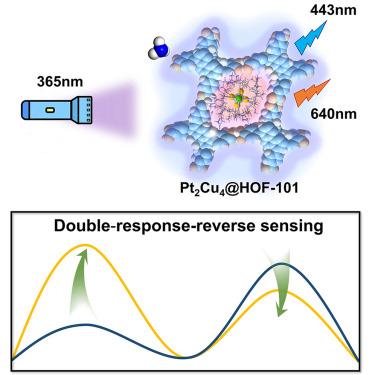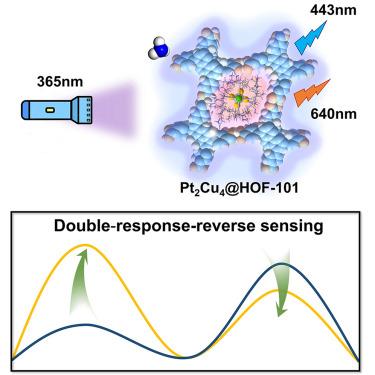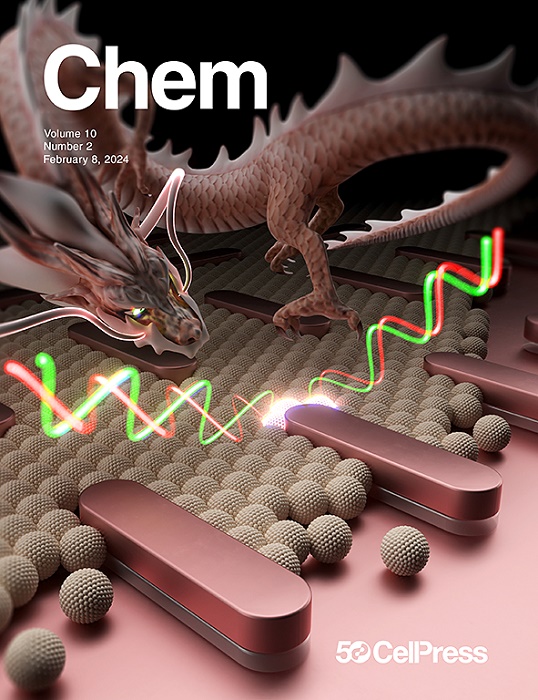金属纳米团簇包封成氢键有机框架用于双响应-反向氨荧光传感
IF 19.6
1区 化学
Q1 CHEMISTRY, MULTIDISCIPLINARY
引用次数: 0
摘要
氨(NH3)被认为是肝脏和肾脏疾病的生物标志物;灵敏和可见荧光传感器有望实现呼吸NH3的定量检测,尽管精度低使其难以应用于呼吸测试。在此,我们采用了“双响应-反向荧光”策略,通过将金属纳米簇(MNC)原位封装到氢键有机框架中,成功构建了超精确的比例荧光传感器(Pt2Cu4@HOF-101)。结合π共轭HOF和发光MNC,两种NH3识别位点被精确组装并引起显著的轨道能量变化,从而实现了对痕量NH3的强烈响应。通过三维电子衍射对精密组装的Pt2Cu4@HOF-101进行了有力的检测,全面揭示了结构诱导的双响应-反向传感机制。值得注意的是,Pt2Cu4@HOF-101能够精确量化呼出的NH3,并且测量的呼气浓度与血液检查高度正相关,这为肝脏和肾脏疾病的无痛诊断提供了一种新的方法。本文章由计算机程序翻译,如有差异,请以英文原文为准。


Encapsulation of metal nanoclusters into hydrogen-bonded organic frameworks for double-response-reverse ammonia fluorescence sensing
Ammonia (NH3) is considered a biomarker of liver and kidney diseases; sensitive and visible fluorescence sensors are expected to achieve quantitative detection of breath NH3, although low accuracy makes them difficult to apply in breath tests. Herein, we adopted a “double-response-reverse fluorescence” strategy via in situ encapsulation of a metal nanocluster (MNC) into a hydrogen-bonded organic framework, successfully constructing an ultra-accurate ratiometric fluorescence sensor (Pt2Cu4@HOF-101). With a combination of π-conjugated HOF and luminescent MNC, two kinds of NH3 recognition sites were preciously assembled and raised significant orbital energy changes, thus realizing a strong response to trace NH3. The precision-assembled Pt2Cu4@HOF-101 has been eloquently inspected by three-dimensional electron diffraction, which comprehensively uncovered the structure-induced double-response-reverse sensing mechanism. Notably, Pt2Cu4@HOF-101 enabled exact quantification of the NH3 exhaled, and the measured expiratory concentration was highly positively correlated with the blood test, which offers a new approach for the painless diagnosis of liver and kidney diseases.
求助全文
通过发布文献求助,成功后即可免费获取论文全文。
去求助
来源期刊

Chem
Environmental Science-Environmental Chemistry
CiteScore
32.40
自引率
1.30%
发文量
281
期刊介绍:
Chem, affiliated with Cell as its sister journal, serves as a platform for groundbreaking research and illustrates how fundamental inquiries in chemistry and its related fields can contribute to addressing future global challenges. It was established in 2016, and is currently edited by Robert Eagling.
 求助内容:
求助内容: 应助结果提醒方式:
应助结果提醒方式:


